With third-party cookies set to phase out of Chrome at the end of 2024, this year will be the last holiday season marketers can use third-party cookies to personalize ads, retarget potential customers, and fuel cross-platform attribution models.
You know what that means: this time next year, data deprecation will have an outsized impact on the most wonderful time of the year. And you need to be ready.
It’s time to start preparing your data strategy now if you want to position your brand for success when the last holiday cookie crumbles. So let’s make sure you know what to expect and how to deploy the right solutions so your 2024 strategy stays merry and bright.
What will marketing look like with no sweet third-party cookie treats next holiday season?
The Chrome phaseout is happening concurrently with the continued rollout of legislation in California (CCPA), Virginia, and other states disallowing the use of Personal Information (PI) collected by third parties with the intent of “selling data.”
These new laws will prohibit the use of cookies for targeting audiences and potential customers, which will have an outsized impact on advertisers’ ability to retarget. By the time the next Black Friday rolls around, you’ll need more than a cookie to get a promotion or offer in front of a qualified customer who had previously left an item in their cart.
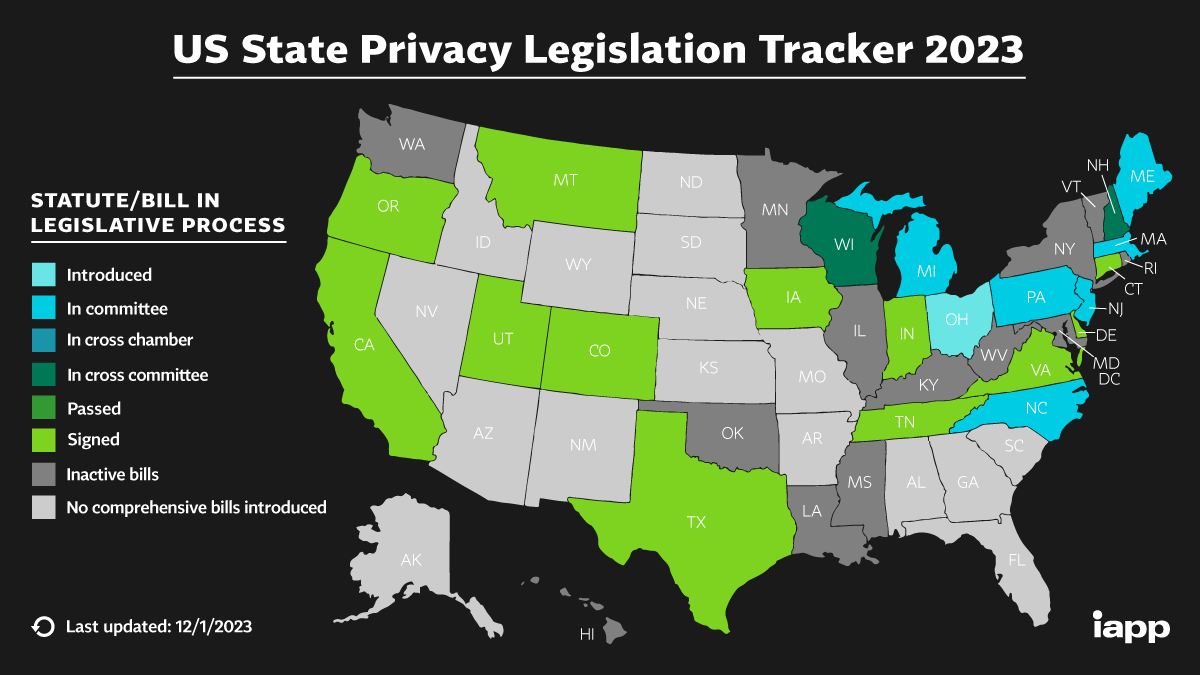
Source: IAPP
The writing’s on the wall: the third-party cookie is on the naughty list and headed for the trash.
Cookies have become such an important part of marketing strategy that it can be hard to picture what measurement will look like once they’re truly gone, even with all of the warnings we’ve heard over the last few years.
One important difference will be shrinking retargeting pools. Without third-party cookies, marketers will no longer be able to target consumers who have visited their brand website. Retargeting will need to be based on first-party (1P) data capture that the customer actually consents to.
Attribution and measurement will also be more limited. You won’t be able to use third-party cookies to track your customers’ exposure to ads on the open web and subsequent events on your website. Attribution will be entirely based on 1P data, leaning heavily towards click-based and last interaction measurement.
That will be a problem when you want to measure the downstream impact of audience priming and awareness-generating campaigns. We expect platforms to continue to lean into modeled conversions as a solution. While the intention and methodology behind modeled conversions are sound, there is an inherent risk that the models doing the conversion assignment could be biased towards legacy trends, which would disrupt campaign optimization as we lose true signal and tracking capabilities.
You can expect broader tracking and measurement to more closely mirror iOS measurement in the future because devices and browsers will become responsible for measurement and attribution, controlling what signals are delivered back to advertisers.
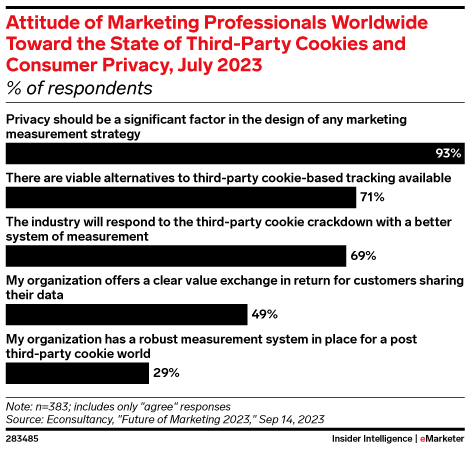
Source: eMarketer
Last but not least, first-party data will become the brightest star in the marketing firmament because both targeting and measurement will shift to rely almost exclusively on first-party data.
How can PETs (privacy enhancing technologies) help you win in a first-party data-centric world?
The upcoming changes may be daunting, but it’s not all bad news. Marketers will soon have a new PET (not Rudolph) to help out–privacy enhancing technologies (PET).
These new technologies are built to combat the problem of third-party cookie loss. PETs are focused on sharing personal information in a privacy-centric way that adheres to future rules and regulations.
Some of the most useful/promising technologies you should get familiar with include:
- Zero-trust data clean rooms: These solutions allow first-party data owned by different parties to intermingle without exposing any personal information. They’re most useful for aggregated measurement of audiences or products.
- On-device measurement (federated learning): This technology processes events and ad exposures on a consumer’s device directly and sends aggregated information back to ad platform servers. That’s different than pixels, which share hit-level data and personal information with advertisers.
- Differential privacy: This tool works by adding noise and randomization to a data set to obfuscate any personal information, so identifiable data can’t be shared directly.
As you’re planning your new cookieless strategy, consider where you can leverage PETs to help you get the most out of your first-party data, protect your customers’ privacy, and obey privacy regulations. The biggest opportunity for most advertisers to integrate these tools directly is through data clean rooms.
There are many data clean rooms out there right now, including multiple offerings from platforms, including Meta (Advanced Analytics), Google (Ads Data Hub), and Amazon (Amazon Marketing Cloud), that allow advertisers to mix their first-party data with ad exposures, clicks, and actions (conversions, video views, etc.) measured inside these platforms.
These are useful for collecting detailed information about the customer journey and how your different customer segments interact with and are influenced by different media on each platform. At Wpromote, we use platform data clean rooms to help optimize our media strategy around flighting, reach overlap, frequency capping, and creative sequencing.
And the clean room phenomenon is growing. Streaming platforms are building clean rooms that allow advertisers to understand how their customers are consuming media and what shows they are watching, while many retailers are building their own to help advertisers identify the products customers are purchasing in-store and at what frequency. All of these options mean more privacy-protecting opportunities to leverage first-party data to uncover detailed insights into your customers.
You need to start experimenting with these solutions now so your brand isn’t left scrambling when cookies are fully phased out next year. Get together with your team to decide which tools will be most useful based on your business model, the data you’re collecting now, and the data you’re expecting to use in the future.
Why is a festive first-party strategy critical to success in a cookieless future?
To succeed in 2024, you’ll need a first-party data strategy that protects customer privacy and works for your brand. This will be very different from past strategies that relied on tracking customer behavior; instead of hunting customers down across the web. Customer consent will be key, but that might not be as much of an obstacle as you’d think.
Customers are often willing to share their first-party data if brands give them a fair value exchange as an incentive. You should start thinking about what kind of value you’re willing to provide: discounts, interactive experiences, special access, or freebies can all convince customers to share their information.
But it’s not just about getting the data; you’ll need to update the way you collect and manage customer information once you’ve got it. Instead of relying on third-party pictures, you’ll need to focus on server-side event tracking.
Server-side data sharing allows data to pass through consent management and opt-out, so it’s a privacy-resilient way to leverage the customer data you capture and share with third parties. At the same time, you should also make sure your privacy policy is up to date with current regulations. The goal is to keep your brand in line with today’s best practices and protect your business from foreseeable risks based on future potential restrictions.
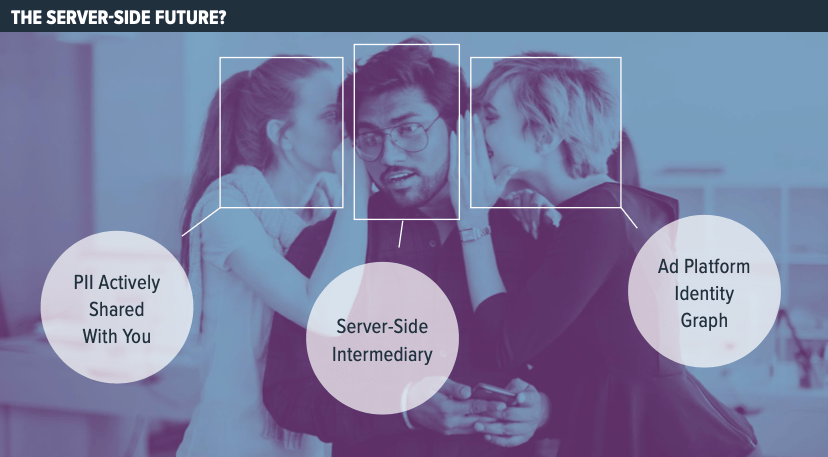
Once marketers lose the ability to retarget consumers based on third-party pixels, managing the flow of your first-party data to ad platforms for targeting will be critical.
Your data should be as close to real-time as you can make it. If you haven’t already, consider onboarding a customer data platform (CDP) to solve for this challenge. If you’d prefer a free solution with less overhead, new platforms like Google’s Ads Data Manager (currently in beta) feature seamless ways to share your 1P data.
Once the industry has migrated to a first-party data model, the kind of attribution marketers have long relied on will no longer be possible. You should re-focus your measurement and optimization strategy and go all in on up-level measurement by implementing incrementality testing, media mix modeling, and data clean rooms. While these solutions are less real-time, they bring other benefits–they’re more holistic and evidence-based than digital attribution.
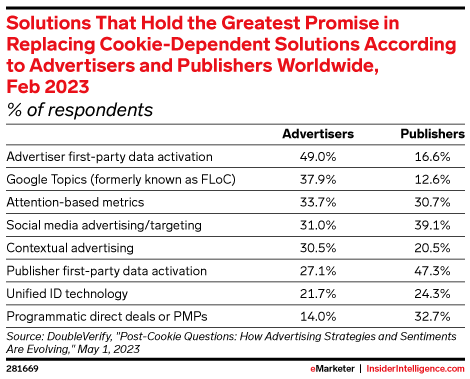
Source: eMarketer
No matter what, make sure your team is planning ahead and testing different solutions long before the 2024 holiday season so you’re ready to win in Q4.
Since this landscape is so new, the ad tech industrial complex is still trying to figure out the best way forward). But your brand can’t afford to wait for an answer: you need to start testing new solutions and platforms to see which works best for your business.
Each solution will have unique benefits and strategies–for example, Unified ID 2.0 by The Trade Desk takes a very different approach to audience targeting than Topics API and PAIR from Google’s Privacy Sandbox. Choosing the right one will be crucial as you adjust to the new status quo.
Losing cookies next holiday season doesn’t mean marketers can’t have the same performance impact with campaigns. It just means you’ll have to get creative and develop innovative data strategies for first-party data capture so you can get the data you need to reach your customers–no icing required.





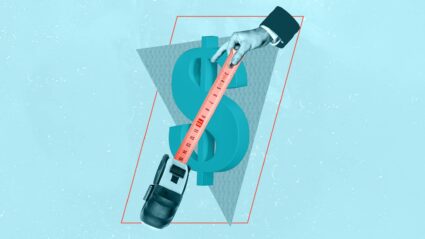

Responses